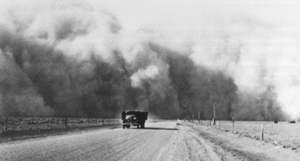Food securityLarge areas of Plains states now drier than during Dust Bowl
As a result of the drought conditions that have largely remained a constant since 2011, parts of the Texas and Oklahoma panhandles, as well as northeastern New Mexico and southeaster Colorado, are now drier than they were during the infamous Dust Bowl of the 1930s. While experts explain that the possibility of another Dust Bowl is not likely due to modern farming and irrigation techniques which have been enacted as a response in the 1930s, greater erosion due to drought and wind has resulted in a number of vicious dust storms.

Truck trying to outrun an incoming dust storm // Source: illinois.edu
As a result of the drought conditions that have largely remained a constant since 2011, parts of the Texas and Oklahoma panhandles, as well as northeastern New Mexico and southeaster Colorado, are now drier than they were during the infamous Dust Bowl of the 1930s. In these areas, the sky can turn brown or pink due to the dust, and in some cases can even block out the sun. Those who remain outdoors grapple with soil in their eyes and mouth.
Nearly all of this is indirectly connected to the persistent lack of rain. As News Daily reports, “The number of dust storms seems to rise with the length of the drought.”
While experts explain that the possibility of another Dust Bowl is not likely due to modern farming and irrigation techniques which have been enacted as a response in the 1930s, greater erosion due to drought and wind has resulted in a number of vicious dust storms. Lubbock, Texas, for instance, has experienced fifteen dust storms in 2014 alone, according to the National Weather Service. Additionally, officials have only begun issuing dust storm warnings in southeastern Colorado within the past year — a telltale sign.
Throughout the decades since the Dust Bowl, farmers have made use of soil conservation advances, which include practices such as strip-till farming where the only disturbed portion of the soil is along the row for seeds. David Ford, a farmer in the Texas panhandle, said, “If it hadn’t been for a lot of these changes, it would really be bad. We would be in the middle of the ‘30s again.”
Meteorologist Justin Weaver of Lubbock summed up the situation when he said that “The drier it is the more opportunities there are for dust to get lofted in the air. We’re not in very good shape.”
